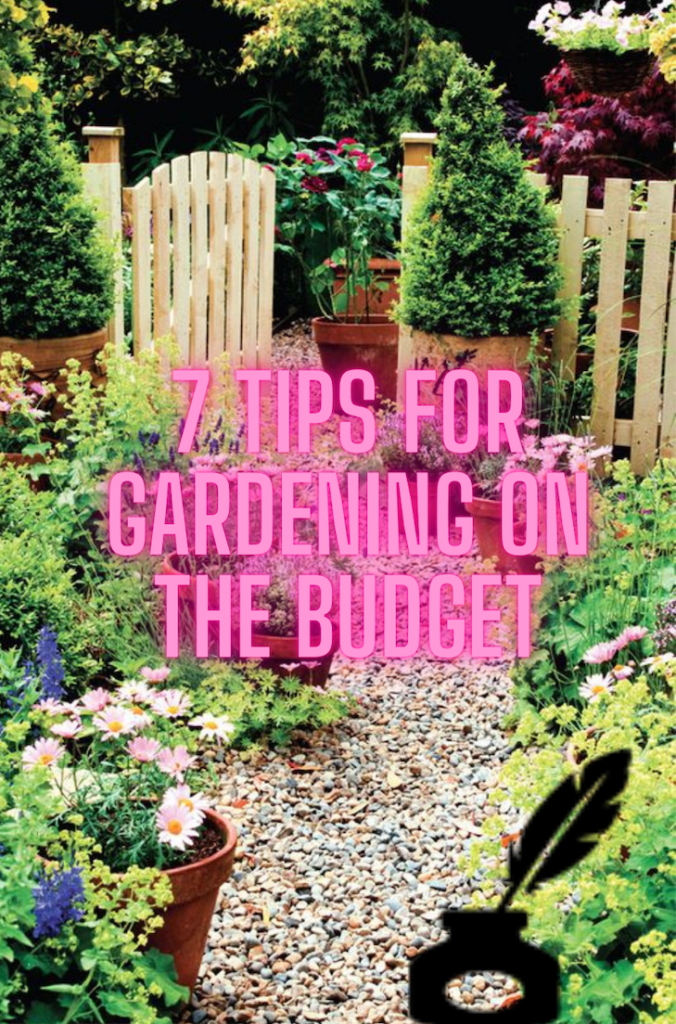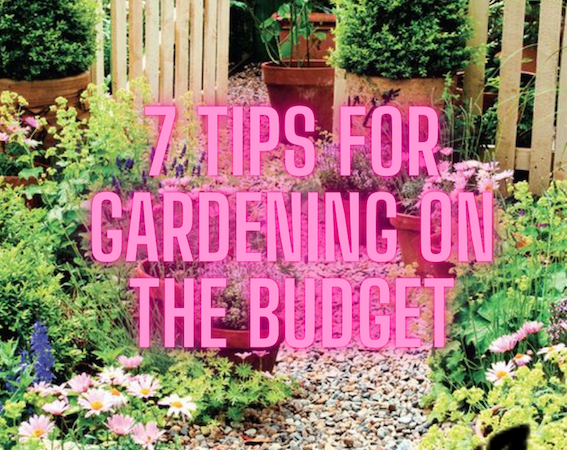
1. Start small and grow your garden gradually.
Starting small and growing your garden gradually is a smart strategy for several reasons. First, it helps you get a feel for gardening and learn about the plants that grow best in your location and soil conditions. This will help you avoid costly mistakes and increase your chances of success. I have been there, trust me!
Second, starting small allows you to focus on a manageable area and properly care for your plants, ensuring they thrive. Third, it helps you build a garden that fits your budget, as you can add new plants and garden features as you go.
When starting small, consider planting a few herbs or vegetables, such as lettuce, basil, or cherry tomatoes. These plants are easy to care for and can provide you with fresh, tasty ingredients for your meals. You can also consider adding a few flowers, such as marigolds, zinnias, or petunias, which are hardy and colourful. As you become more experienced, you can expand your garden and add new plants and features, such as a trellis or raised beds.
Starting small and growing your garden gradually is a smart and sustainable approach that can help you avoid overspending and make your money go further.
2. Buy seeds instead of plants.
Buying seeds instead of plants is a cost-effective way to start a garden, as seeds are typically much cheaper than plants. For example, a packet of seeds can cost anywhere from a few cents to a few dollars, while a single plant can cost several dollars. By purchasing seeds, you can save money while still having the opportunity to grow a wide variety of plants.
When buying seeds, it’s important to choose seeds that are well-suited to your location and the time of year you plan to plant them. For example, if you live in a warmer climate, you may want to choose seeds for warm-season crops, such as tomatoes, peppers, or melons. If you live in a cooler climate, you may want to choose seeds for cool-season crops, such as lettuce, spinach, or kale. Stevia refused to thrive in my garden.
Another benefit of buying seeds is that you can grow heirloom or non-GMO varieties, which can be more difficult to find as plants. These seeds can be more expensive than traditional seed varieties, but they often produce healthier, more flavourful crops.
To give you an idea of the cost savings, let’s consider a comparison. If you were to purchase a packet of seeds for $2.00 and grow 10 plants, you would have spent $0.20 per plant. On the other hand, if you were to purchase 10 plants for $4.00 each, you would have spent $40.00. That’s a significant difference in cost!
3. Repurpose and recycle materials for your garden.
Repurposing and recycling materials for your garden is a smart and environmentally friendly way to save money while creating a unique and personalized look for your garden. There are many items around your home that can be used in your garden, such as pots, containers, trellises, and even old furniture.
For example, you can use old buckets, containers, or even laundry baskets as planters for your plants. You can also repurpose wooden pallets, trellises, or fencing to create raised beds or to support climbing plants. Another example is using old furniture, such as chairs or tables, as unique garden decorations or planters. You can use a bit of paint to create a fresh and personalised look that will match your garden colour scheme.
Personally, I would always choose any materials other than plastic in my garden as I feel it does not give a garden natural feel and texture, looks out of place, cheap and irrelevant; and you cannot make any changes to it.
In addition to repurposing items, you can also recycle materials for your garden. For example, using leaves and other garden waste as mulch helps to retain moisture in the soil and reduce weed growth. Composting kitchen scraps, such as vegetable peelings and eggshells, can also create a rich, organic soil amendment that helps your plants thrive.
4. Plan and prioritise your garden expenses.
Planning and prioritizing your garden expenses is an important aspect of gardening on a budget. By planning ahead and determining what is most important for your garden, you can allocate your resources in the most effective way.
For example, you may want to prioritize purchasing quality soil and compost, as these are the foundation of a healthy and productive garden. You may also want to prioritize purchasing essential tools, such as gloves, a trowel, and pruning shears, which will make your gardening tasks easier. I found that having a one pair of good pruning shears is enough for day-to-day tasks, so I bought Niwaki shears which I love and use all the time.
On the other hand, you may choose to hold off on purchasing more expensive items, such as decorative garden features or high-end plant varieties, until you have established a solid foundation for your garden. By doing so you can determine what to invest in first which is often overlooked by gardeners who want it all and want it now.
5. Plan your garden layout carefully.
Planning your garden layout is an essential step in creating a beautiful and productive garden, and it can also help you save money by maximizing your space and resources. By taking the time to plan your garden layout, you can ensure that you are making the most of your plants and that your garden is both functional and aesthetically pleasing.
When planning your garden layout, there are a few key factors to consider. First, think about the sun exposure your garden will receive. Different plants have different sunlight requirements, so it’s important to consider this when deciding where to place them. For example, if you have a sunny area in your garden, you might consider planting vegetables that need full sun, such as tomatoes or peppers. Mistake I made was not considering where the sun is at different times of the day, so I spent a lot of time re-planting my flowers and buying more suitable topsoil for them which costed me more that it should have.
Next, think about the soil type in your garden. Different plants have different soil requirements, so it’s important to consider this when making your plan. For example, if you have heavy clay soil, you might consider planting plants that are tolerant of heavy soils, such as blueberries or hydrangeas; remember though- they both like rather acidic soil.
Finally, think about water availability in your garden. Consider installing a drip irrigation system, which can help you conserve water and save money on your water bill. You can also take advantage of rainwater collection to water your plants for free and providing them with the best quality water without fluoride and other added substances that you will find in tap water.
To help you get started, consider sketching out a rough plan of your garden on paper. You can also use garden planning software or apps to help you visualize your garden layout. This is a fun and creative process; well, it was for me, and my drawing skills are far from perfect to say the least.
6. Shop around for gardening supplies and plants.
One of the best ways to save money is by taking advantage of deals, discounts, and free resources. From seed and plant swaps with friends to shopping sales at your local garden centre, or even visiting second-hand stores for gently used gardening supplies. The key is to be a smart buyer and not just buy the first thing you see particularly if you are not quite sure where to put it or if you have enough space for it.
Take the time to compare prices, quality, and features so that you can find the best value for your money. Try to buy small plant plugs and watch them grow instead of being tempted to get a full-size plant for instant look.
Look out for offer sales as many garden centres have sales throughout the year. It is particularly good if you like perennials/ herbaceous plants as at certain times you can buy them heavily discounted, yet you will enjoy them for years to come.
Wisely choose annual plants. They can be a beautiful addition to your garden, but they can also eat up your budget quickly if you are not careful. Unlike perennials, which come back year after year, annuals must be replanted each season, which can add up in cost.
Consider the size of your garden and the amount of sun exposure it receives when choosing annual plants. Some annuals can grow quite large and take up a lot of space, so it’s important to choose plants that will fit in the space you have available.
Consider using annuals sparingly and in combination with perennials. Annuals can be a great way to add seasonal colour to your garden and blending few of them with perennials will not drain your pocket that much.
7: Reuse and recycle
Reuse garden beds and pots – If you have old garden beds or pots that are still in good condition, consider reusing them in your garden. You can also repurpose old containers such as crates, baskets, or even old boots to make unique and creative garden beds.
Recycle plants – If you have plants that have outgrown their space, consider moving them to a new location in your garden. You can also divide perennials and share them with friends or keep them. This way you will get more plants of the same plants without spending money. This is also a great way to achieve group planting where you have few of the same species in one spot to draw more attention to it.
Don’t throw away plants that have gone to seed – If a plant has gone to seed you can collect the seeds and grow them in a new location for next season, or even share the seeds with friends and family.

